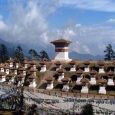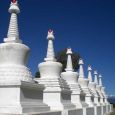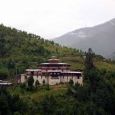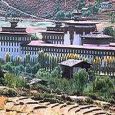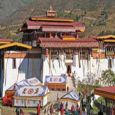Thimphu
Advertisement
Roads
The layout and position of the city roads in Thimpu are dictated by its unique topography. Most premier roads, typically wide, are aligned in a north-south direction, parallel to the river; the most important artery is the Norzin Lam (Lam - road/street). Branch roads wind along the hill slopes leading to residential areas. Foot paths are also well laid with access to the commercial areas and the Wang Chuu River. However, its entry point is at a narrow location from the south crossed by a wooden bridge. South of the bridge is the road to Paro, Punakha, Wangdi Phodrong, Tongsa and further to the east and north.The expressway which has been built has had a large impact on development, shifting land values, decreasing transportation costs, and increasing potential growth opportunity in the southern part of the valley.
Bhutan Transport Corporation runs a regular bus service from Siliguri (which along with nearby New Jalpaiguri station are the nearest railheads) in India. It takes about four hours to reach Phuentsholing. From there, buses ply to Thimphu every day. Taxis could also be hired to Thimphu.
The unique aspect of Thimphu roads and the traffic control over the road net work is that it is one of the two national capitals in Asia that does not have traffic lights (the other is Pyongyang, North Korea). Local authorities had installed a set of lights but before they became operational the lights were removed. Instead of traffic lights, the city takes pride in its traffic police that directs the oncoming traffic with their dance-like movement of their arms and hands.City Bus services operate throughout the day. There are plans to introduce tram services in the city.
Air
Passengers disembarking from Druk Air's Airbus A319 at Paro Airport.
Thimphu does not have an airport. However, it is served by the only international airport of Bhutan at Paro, which is about 54 kilometres (34 mi) away by road. Druk Air had its headquarters in Thimphu but now there is only a branch office.Druk Air is the only airline flying into Bhutan and is a lifeline with the outside world for the Bhutanese people.
Tashichho Dzong
Tashicho Dzong, the main secretariat building, houses the main government departments, all the Ministries, the National Assembly Hall, the office of the King and the Throne Room and summer headquarters of the Central Monastic Body. It is also the summer residence of the monk body and the religious chief, the Je Khempo. This dzong was first built in 1661, and dominates the town of Thimphu. Except the central keep, the entire structure was rebuilt in 1961-62. In the National Assembly Hall, there is the two-storey high statue of Lord Buddha, wall paintings which depicts the twelve stages of Buddhahood and columns of Kanju and Tenju that depicts the supremacy of religion over politics. The yearly Thimphu Festival is held in the courtyard directly in front of the National Assembly Hall. The two largest Thankas are housed in the Uchi, the tall citadel-type temple in the middle of two courtyards. These thankas are displayed to the public only once in 25 years. During the renovation of Tashicho Dzong, the Uchi was left undisturbed.
Tashichho dzong is Bhutan's most stately and arguably the most impressive building. It houses the throne room of His Majesty the King of Bhutan and is the summer residence of the venerated monastic community. The current dzong is the impressive result of a redesign of the original medieval structure sanctioned by the Third King, His Majesty King Jigme Dorji Wangchuk, when he moved the capital to Thimpu from Punakha.
Simtokha Dzong
The Simtokha Dzong is situated on a lofty ridge, about 8 kms from Thimphu.This dzong was built in 1627 by Shabdrung Nawang Namgyel, the first king ofBhutan. This dzong is the oldest Dzong in Thimphu and gateway to the ThimphuValley. This dzong still enjoys the strategic importance as it did in 1627.The Dzong houses Rigney School for Dzongkha and monastic studies. There are beautiful frescos and slate carvings in Simtokha.
Simtokha Dzong officially known as Sangak Zabdhon Phodrang (Palace of the Profound Meaning of Secret Mantras), Simtokha Dzong was built in 1629 by Shabdrung Ngawang Namgyal. It is often said to be the first dzong built in Bhutan. In fact, there were dzongs in Bhutan as early as 1153, but this is the first dzong built by the Shabdrung, is the oldest that has survived as a complete structure, and is the first administrative facilities. It is the home of the Institute for Language and Culture Studies; the students are both monks and lay people.
Stupa
The stupa-styled monument is also situated in Thimphu. This monument is dedicated to the late King, His Majesty Jigme Dorji Wangchuck, the father of modern Bhutan. The paintings and statues inside the stupa provide a rare insight into Buddhist philosophy.
The Bhutanese word is Chorten, which means “the basis of offering”.
It is a symbol of enlightened mind, (the awakened mind, universal divinity) and the path to its realisation.
If you had to use just two words, the best definition I have seen is “Spiritual Monument”
The stupa represents the Buddha’s body, his speech and his mind, but most especially his mind and every part shows the path to Enlightenment
“The visual impact of the stupa on the observer brings a direct experience of inherent wakefulness and dignity. Stupas continue to be built because of their ability to liberate one simply upon seeing their structure” – Chogyam Trungpa Rinpoche
The Nepali-Style Chorten is based on the classical stupa. On the Nepali chorten, sides of the tower are painted with pair of eyes, the all-seeing eye of Buddha. What appears to a nose is actually the Sanskrit character for the number one, symbolizing the absolute ness of Buddha. The large Chortenkora in Trashi Yangtse and Chendebji chorten near Trongsa are two examples of this style.
The Tibetan-Style Chorten has a shape similar to a stupa, but the rounded part flares outward instead of being a dome shape. National Memorial chorten in Thimphu is an excellent example of this style.
The Bhutanese Design comprises a square stone pillar with khemar near the top. The exact origin of this style is not known, but is believed to be a reduced form of the classical stupa, with only the pinnacle and square base. Some Bhutanese chorten have a ball and crescent representing the moon and the sun on the to
Information not available


